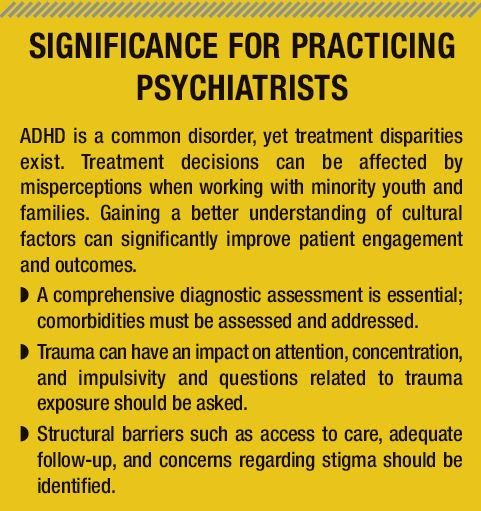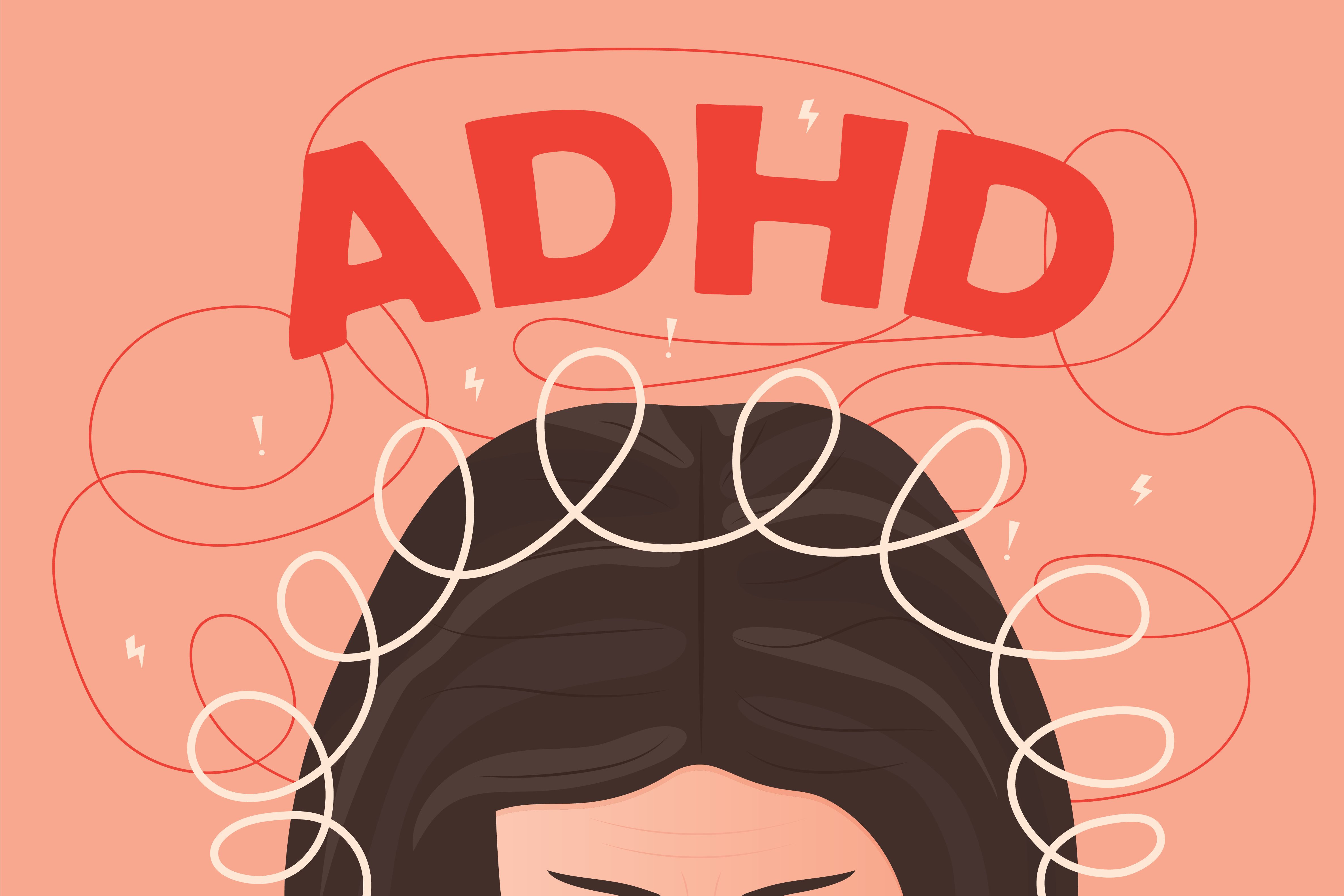Publication
Article
Psychiatric Times
Culturally Competent Approaches to ADHD: Issues in African-American Populations
Author(s):
Mental health stigma has been found to be a significant factor in African-American treatment engagement. For this reason, taking steps to understand cultural considerations is key.
Shutterstock.com/Andrey_Popov

SIGNIFICANCE FOR PRACTICING PSYCHIATRISTS

There is no single African-American experience. Consider three different 8-year-old African-American boys, one each from the Mississippi delta, Chicago’s inner city and Prince George’s county’s affluent suburbs. Their cultures will have significant differences, and a cookbook cultural competency model would not serve them well. While consideration of these issues regarding ADHD in African-Americans is helpful, cultural humility is a must within each individual patient encounter. Cultural competency implies an endpoint; however, cultural humility embraces a lifelong process that includes self-reflection, introspection, advocacy, and co-learning.
ADHD is a common and treatable disorder that can have significant implications for social, educational, and occupational trajectories. Diagnosis rates have increased over time. Based on parent report data from the National Survey of Children’s Health, 2011 to 2013, the percentage of youth aged 4 to 17 years with a diagnosis of ADHD increased significantly from 7.0% to 10.2% overall and from 5.5 % to 9.6% in non-Hispanic black children.1
Diagnosis, assessment, and barriers
On one hand, while early identification is the goal, ADHD’s prevalence can lead to over-diagnosis with less emphasis on co-occurring disorders. All that fidgets is not ADHD. This may be particularly relevant in black populations. Multiple environmental and psychosocial issues that disproportionately affect African-American youth may consequently manifest in symptoms that overlap with those of ADHD. On the other hand, African-Americans in general are disproportionately affected by structural barriers to care as well as by stigma regarding mental illness. These factors can lead to underdiagnosis or delays in diagnosis.
Trauma can affect attention, concentration, and impulsivity. The Adverse Childhood Experiences (ACEs) studies revealed that the incidence of childhood exposures to two or more adverse experiences was higher in blacks than Hispanics or whites. Although the higher the income, the lower the trauma load overall, this relationship was less pronounced for blacks. In other words, income did not appear to be a protective factor. In fact, middle-income blacks had a higher percentage of two or more ACEs than middle class or nearly poor whites.2
Asking directly about traumatic exposures is an absolute necessity in working with black youth and families. While trauma-related diagnoses are by no means mutually exclusive with ADHD, if both are present, it is imperative that the family is educated about the psychological impact of trauma and that treatment interventions target both issues.
Disparities also exist with regard to environmental neurotoxic exposures. Cassidy-Bushrow and colleagues3 point out that African-American children have the highest prevalence of elevated lead blood levels in the US. Furthermore, the disproportionate burden of lead exposure is transmitted from mother to child, thus the burden of higher lead exposure starts in utero and persists into childhood.
Alcohol exposure in-utero is another consideration as fetal alcohol spectrum disorders can have overlapping symptoms with ADHD. Although a study of a representative sample in a Midwestern community did not find differences across races, Dr Carl Bell, has noted that in a retrospective chart review, alarmingly high rates of fetal alcohol exposure were found in poor African-American populations.4,5
Research regarding African Americans and ADHD diagnosis is limited; however, there are some notable findings. Racial and ethnic disparities exist in the diagnosis of ADHD. One 10-year review found that African-American youth had a diagnosis only two-thirds as often as white youth.6 While more research is needed to better understand diagnostic disparities among African-American youth, there are known variables that affect health equity. Structural barriers that have a disproportionate impact on black families include insufficient financial resources, uninsured or underinsured status, and inadequate access to and availability of care. Even in African-American families unaffected by these issues, treatment-seeking behaviors can result in delays or the absence of diagnosis. This could be due to the concern of stigma regarding mental illness and/or double stigma, or fear that the burden of racism will be compounded by the stigma of mental illness. Furthermore, encounters of racism within the health care system can compromise trust, undermining treatment engagement.7
Informed consent, psychosocial considerations, and treatment engagement
After a diagnosis is made, there are additional cultural considerations in the informed consent and treatment engagement process. Findings indicate that among children with ADHD, African-American youth were less likely to be on a prescribed medication. This disparity occurred as early as kindergarten and continued to at least the end of eighth grade.8 Educational disciplinary procedures, failure to complete high school, and juvenile justice involvement disproportionately affect black youth. While the reasons for these disparities are multifaceted and complex, the harsh reality is that society gives black youth less room for error. A thorough informed consent process must include a candid discussion about not only the risks of intervention, but also the risks of untreated ADHD.
The same structural barriers that can impede access to assessment and diagnosis can have an impact on treatment engagement. When Cummings and colleagues9 looked at racial and ethnic differences in ADHD treatment among Medicaid-enrolled youth, it was found that the most important disparity was medication discontinuation among minorities and that medication discontinuation was associated with disengagement from any type of treatment for ADHD, including behavioral interventions. It was also noted that African-American youth were less likely to receive adequate follow up both in the initiation phase of ADHD medication and in the continuation and maintenance treatment phase. Moreover, if a comorbid disorder such as PTSD is not addressed, poor treatment response may lead to disengagement with mental health interventions altogether.
Another consideration is the disproportionately harsh legal consequences faced by members of the black community who have substance use disorders. These experiences can lead to increased fear of addiction to psychiatric medications. It is important that families are informed of the elevated risk of substance use disorders in youth with untreated ADHD and that treatment lowers the risk for a substance use disorder.
Psychosocial interventions
The implications of health disparities related to ADHD and the African-American community are far-reaching. Effective treatment plans require a comprehensive approach in the school, community, and mental health treatment settings.
Inadequate interventions in the school setting can result not only in academic difficulties, but can also set off a chain of events leading to legal problems. The school to prison pipeline is a well-documented phenomenon wherein academic disciplinary actions lead to juvenile and/or criminal justice system involvement. If symptoms are significantly more pronounced in the school setting or in classes that rely on a common skill set (eg, reading, language arts, social studies), psychoeducational testing is needed.
Because of a history of discrimination and segregation within school settings, African-American parents may be reluctant to have their child undergo psychoeducational testing or to initiate an evaluation for an Individualized Educational Plan (IEP). It is important that parents understand the need to address ADHD as well as any learning or cognitive issues to enable their child to reach his or her full academic potential. Education regarding the child’s rights throughout the evaluation and plan-development process as well as the range of IEP interventions available is helpful. Even in the absence of comorbid learning or cognitive issues, parents should be made aware that ADHD alone may qualify their child for an IEP and that this confers protections regarding suspensions and expulsions for diagnosis-related behaviors.
Mental health stigma has been found to be a significant factor in African-American treatment engagement. For this reason, taking steps to bolster the families’ exposure to supportive contacts, both in the community and within the mental health system can be critical interventions. Identification of and links to supportive contacts can be particularly helpful. With regards to treatment planning, the most effective one is the one the family can and will implement. In a family with transportation problems and openness to home visits, in-home services may be preferred. In a family that lives close to their PCP and is reluctant to go to a mental health clinic, integrated care may be the best fit.
Implementing treatment
When implementing treatment, establishing a therapeutic relationship is an important first step. A multimodal system of care approach allows for individualization, flexibility, and identification of family strengths. This approach also supports the utilization of community resources as illustrated in the Case Vignette.
CASE VIGNETTE
A six-year-old African-American boy was brought in by his mother because of major concerns regarding disruptive behavior in the school setting and difficulty in his after-school program. His mother felt that at home his behavior was typically manageable but there were concerns. In fact, the mother reported that he had been “kicked out of head start.”
The boy’s mother presented as a concerned and engaged parent. Focusing on establishing a therapeutic alliance with the mother, emphasis was placed on gaining trust and conducting a strength-based comprehensive evaluation. Findings were consistent with severe ADHD and treatment options were explored and included pharmacotherapy combined with other therapeutic interventions. Education regarding ADHD as a neurodevelopmental disorder was provided.
The mother clearly expressed a preference of focusing on the child’s diet. She was fearful of any medication because of family members’ concerns regarding addiction. Her concerns were acknowledged and addressed, she was encouraged to return on a regular basis to monitor how the child was doing.
At a follow-up visit, the boy’s mother became very upset because of the school’s plan to initiate an evaluation for an IEP to determine appropriate placement based on significant documentation that the boy could not function in a regular classroom setting. His mother was concerned about her legal rights and how this would affect his future.
At this point, the mother was open to attending our multifamily parenting group sessions and she was open to her child attending our ADHD group. This proved to be beneficial to both the mother and her son. The mother was able to connect with other parents, many of whom were comfortable with ADHD medications and openly shared their experiences. Eventually the mother agreed to pharmacotherapy as an additional component to the overall treatment plan.
The boy participated in our ADHD group and while he initially perceived and referred to himself as being “bad” he was able to progress within the group where positive re-enforcement, social skills, and problem-solving strategies were utilized. His mother was connected with Parents Educating Parents (PEP), a community-based group of parents knowledgeable about parental rights, whose members volunteer to attend school and IEP meetings with concerned parents.
Conclusion
The need for comprehensive diagnostic assessment is vitally important and comorbidities must be addressed. We must also clearly inform families of the risk of not treating ADHD. Cultural humility demands that providers be flexible in their approach, keep the door open, and embrace families where they are.
Disclosures:
Dr Mattox is Professor and Chair, Dr Vinson is Associate Professor, Department of Psychiatry and Behavioral Sciences, Morehouse School of Medicine, Atlanta, GA.
The authors report no conflicts of interest concerning the subject matter of this article.
References:
1. Pastor PN, Reuben CA, Duran CR, Hawkins LD. Association between diagnosed ADHD and selected characteristics among children aged 4-17 years: United States, 2011–2013. NCHS Data Brief, no 201. Hyattsville, MD: National Center for Health Statistics, 2015. https://www.cdc.gov/nchs/data/databriefs/db201.pdf. Accessed August 9, 2018.
2. Slopen N, Shonkoff JP, Albert MA, et al. Racial disparities in child adversity in the US. Am J Prevent Med. 2016;50:47-56.
3. Cassidy-Bushrow A, Sitarik A, Havstad S, et al. Burden of higher lead exposure in African Americans starts in utero and persists into childhood. Environ Int. 2017;108:221-227.
4. May PA, Baete A, Russo J, et al. Prevalence and characteristics of fetal alcohol spectrum disorders. Pediatrics. 2014;134:855-866.
5. Bell C. Fetal alcohol exposure among African Americans. Psychiatr Serv. 2014;65:569.
6. Miller TW, Nigg JT, Miller RL. Attention deficit hyperactivity disorder in African American children: what can be concluded from the past ten years? Clin Psychol. 2009;29:77-86.
7. Bailey RK, Jaquez-Gutierrez MC, Madhoo M. Sociocultural issues in African-American and hispanic minorities seeking care for attention-deficit/hyperactivity disorder. Prim Care Companion CNS Disord. 2014;16(4).
8. Morgan PL, Staff J, Hillemeier MM, et al. Racial and ethnic disparities in ADHD diagnosis from kindergarten to eighth grade. Pediatrics. 2013;132:85-93.
9. Cummings JR, Ji X, Allen L, et al. Racial and ethnic differences in ADHD treatment quality among Medicaid-enrolled youth. Pediatrics. 2017;139:2016-2444
10. Alvarado C, Modesto-Lowe V. Improving treatment in minority children with attention deficit hyperactivity disorder. Clin Pediatr (Phila). 2017;56:171-176.






